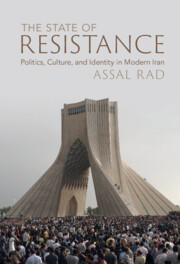Book contents
- The State of Resistance
- The State of Resistance
- Copyright page
- Dedication
- Contents
- Figures
- Acknowledgments
- Note on Transliteration
- 1 Introduction
- 2 The Foreign Shah and the Failure of Pahlavi Nationalism
- 3 The Islamic Republic and Its Culture of Resistance
- 4 Iranian Identity and Popular Music
- 5 Media and the Struggle over Representation
- 6 Conclusion
- 7 Epilogue
- Select Bibliography
- Index
5 - Media and the Struggle over Representation
Published online by Cambridge University Press: 18 August 2022
- The State of Resistance
- The State of Resistance
- Copyright page
- Dedication
- Contents
- Figures
- Acknowledgments
- Note on Transliteration
- 1 Introduction
- 2 The Foreign Shah and the Failure of Pahlavi Nationalism
- 3 The Islamic Republic and Its Culture of Resistance
- 4 Iranian Identity and Popular Music
- 5 Media and the Struggle over Representation
- 6 Conclusion
- 7 Epilogue
- Select Bibliography
- Index
Summary
Chapter 5 explores Iranian cinema and television. While cinema and television were important mediums before the revolution, they became especially significant after the revolution in legitimating the newly established Islamic Republic. Media has been used and often tightly controlled by the I.R. for its own ends, but after the war artistic expression became gradually more relaxed and Iranian cinema began to flourish in the late 1990s. In spite of its international acclaim however, cinema in Iran still operates with structured guidelines and artists have come under severe pressure from authorities. Here, we see the interaction of the state and the people and the contest over media and identity formation. While popular films such as Āzhāns-e Shishehi (The Glass Agency) and Ekhrāji-ha (The Rejects) picked out themes from the Iran–Iraq war, both films also challenged stereotypes and depictions of the war. Films like A Separation captivated Iranian audiences for their realism in portraying multifaceted characters and stories of everyday life. The characters in these films questioned the simple binary of good and bad often depicted in war films. Instead, they added layers and nuance to the nature of Iranian people, the lives they lead, and the complexity of their identities.
Keywords
- Type
- Chapter
- Information
- The State of ResistancePolitics, Culture, and Identity in Modern Iran, pp. 139 - 168Publisher: Cambridge University PressPrint publication year: 2022



